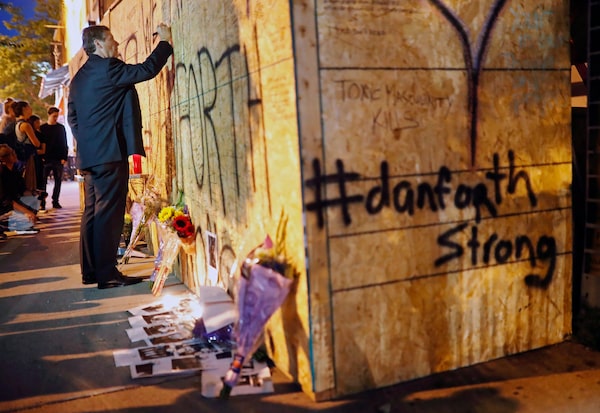The mayor of Canada’s largest city says the country needs a single source of national data about where handguns come from and how they fall into the hands of criminals.
Toronto Mayor John Tory called it “a big problem” that so little is known about the origins of the firearms discharged in violent incidents, including what proportion are stolen or diverted from legal domestic sources.
“I think that we – we meaning the public – should have that data available,” Mr. Tory said in an interview Sunday. “Even I, as a decision-maker and an elected leader, don’t know for sure what the numbers are.”
In the absence of a clear national picture, he said, it’s more difficult to craft effective gun-control policy.
“[If] somebody – a trusted body like Statistics Canada – could collect and consolidate that information and report it to the public, it would be helpful," he said.
Mr. Tory was responding to a year-long Globe and Mail investigation that found Canada is doing an abysmal job of tracking where the guns used in crimes actually come from.
The number of gun homicides across Canada continues to climb: By the end of 2018, it hit 249 (up 60 per cent since 2014). Shootings in Toronto notched a record high of 428.

Toronto Mayor John Tory leaves a personal message on a makeshift memorial remembering the victims of the Danforth shooting, in 2018.Mark Blinch/The Canadian Press
On Friday, Liberal Leader Justin Trudeau promised to ban military-style assault weapons and allow municipal handgun bans in provinces that support them.
That promise fell short of calls from Mr. Tory and his counterparts in Ottawa, Montreal and other cities for an outright national ban on handguns, but Mr. Tory still welcomed it as a step in the right direction.
Asked Sunday how a re-elected Liberal government would improve the collection of gun-related data, Mr. Trudeau pointed to previous commitments to monitor the bulk sales of handguns and enhance the gun-monitoring powers of police.
Bill Blair, the former Toronto police chief who is running for re-election as a Liberal candidate in Scarborough Southwest, said his party’s approach to gun crime tries to strike a balance between public safety and respecting responsible gun owners in Canada.
“There is nothing in our platform that in any way impedes hunters and farmers in the use of their weapons for very legitimate, and traditional hunting and sporting activity," Mr. Blair said in an interview Sunday. "But at the same time, we are taking the common sense, effective measure to make it far less likely those firearms will end up in the hands of criminals.”
Mr. Blair suggested the Liberals’ approach would also allow municipalities to adopt additional restrictions, including, for example, prohibiting restricted weapons from being stored anywhere other than a gun range.
For his part, Mr. Tory said he hoped to persuade Ontario Premier Doug Ford to let Toronto proceed with a ban, despite a spokeswoman for Mr. Ford reiterating his opposition to the idea Sunday.
"The Premier doesn’t believe in blaming law-abiding hunters and gun-owners for the crimes of gang members,” Kayla Iafelice said by e-mail.
Mr. Tory and Toronto City Council began agitating for a handgun ban after a 29-year-old man with a history of mental illness opened fire on Danforth Avenue on July 22, 2018, killing an 18-year-old woman and a 10-year-old girl and wounding 13 others before shooting himself.
The Globe confirmed through police sources that the .40-calibre Smith & Wesson M&P handgun used in the Danforth shooting was stolen from a Saskatchewan gun shop in 2016.
The Globe used access-to-information laws to obtain dozens of federal, provincial and municipal databases on guns, but found the information was too spotty to create a cross-country picture of where guns originate.
Smaller Canadian police forces usually don’t trace the guns they seize, particularly if tracing won’t help solve a crime.
When guns are traced, the results are often kept in written form in individual case files. Police forces across the country said it would take hundreds or even thousands of hours to collate the data and fulfill The Globe’s access-to-information requests.
None of the 36 municipal police forces from which The Globe requested firearms-tracing data were able to provide it.
However, The Globe was able to obtain internal reports from the Toronto Police Service that show the portion of what are known as crime handguns seized by the force and tracked to a domestic source rose from 26 per cent to 44 per cent between 2013 and 2016, before declining to 32 per cent in 2017 and 22 per cent in 2018.
The federal Conservatives, in explaining their opposition to a handgun ban, cited Toronto Police Chief Mark Saunders’s past comments that 80 per cent of firearms used in a Toronto crime could be traced to a U.S. source.
“It is with these comments in mind that we released a three-pronged strategy for dealing with gun and gang crime: cracking down on gangs, gun laws that target criminals and equipping police," Daniel Schow, a spokesman for Conservative Leader Andrew Scheer, said by e-mail Sunday.
When asked on Sunday about the issue of a handgun ban, the NDP did not respond to comment. But the party has said in its election platform that it would give municipalities the choice to ban handguns in their own jurisdictions.
With reports from Marieke Walsh, Kristy Kirkup, Patrick White and Tom Cardoso
Editor’s note: An earlier version of this article referenced the number of gun deaths. It was referring to gun homicides and does not include gun suicides.
Our Morning Update and Evening Update newsletters are written by Globe editors, giving you a concise summary of the day’s most important headlines. Sign up today.